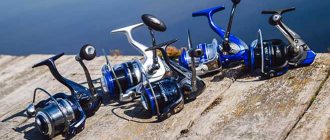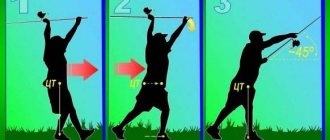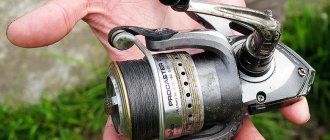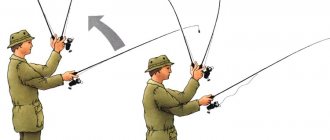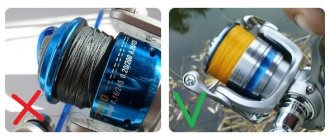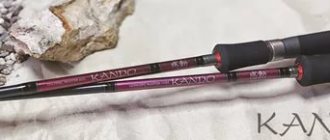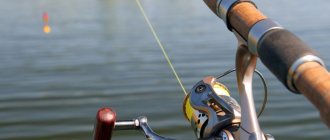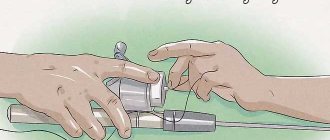What types of casts are there?
To deliver spinning bait to a specific point, anglers use several types. The main ones include:
- vertical;
- horizontal;
- pendulum;
- two hands;
- from under the hand;
- two hands over the head;
- over shoulder.
To be able to fish in any conditions, a beginner must learn all the species. Only such a thorough approach will help you reach fish sites both on a small, overgrown river and in a vast area of lakes and reservoirs.
Vertical, aka classic
On large and medium-sized reservoirs, the banks of which are free of dense vegetation, in most cases you can use the classic or, as it is also called, “vertical” type of casting.
Holding the spinning rod in a vertical position, the angler pulls its tip back and sends the bait to the intended point with a powerful send. This method has several advantages:
- ease of implementation;
- quite high accuracy;
- range.
The disadvantages include the mandatory presence of free space behind the fisherman's back. If the bank is overgrown with trees, performing a classic cast will be problematic. This type will also be ineffective in the case when a spinner or wobbler needs to be sent under a bush hanging over the pool. Since the bait flies high when performing a vertical send, you should pay attention to power lines that may pass over the water.
Holding the form with both hands
To increase the vertical casting distance you will need to use two hands. The right hand should be located in the area of the reel seat (if the person is right-handed), and the left hand should be at the bottom of the handle.
When performing a throw, the right hand moves forward slightly. Left - sharply pulled towards the body. This type is a power type, so there is an increased load on the tackle. To avoid breaking the spinning rod, do not wind the monofilament in such a way that it extends beyond the top edge of the spool. Otherwise, the cord will get tangled and stuck in the guide rings.
There are several other factors to take into account:
- the diameter of the guide rings is too small and the weight of the bait is insufficient, which will not allow you to cast it over a long distance;
- the use of an excessively thick fishing line greatly reduces not only the casting distance, but also the accuracy of casting;
- The winding of the monofilament should initially be tight and uniform.
When fishing on a river, you must first estimate the speed of the stream and understand which trajectory the bait will take, and only then cast it.
Horizontal or side
Having mastered the horizontal or side casting method, the fisherman will be able to fish in places where tree branches hang over his head. When using this method, the bait flies low above the water, so it is not difficult to send it under the opposite bank, densely overgrown with bushes.

The sequence of actions remains the same as when performing a classic throw. The only difference is that the rod is located in a horizontal plane. For a beginning spinning player, the main problem is the timely removal of the index finger, which fixes the monofilament. If you hurry or delay with this action, the bait will fly in the wrong direction.
Underhand throw
Throwing from under the hand is more often used in small bodies of water, when the bait needs to be placed in a certain place:
- window in aquatic vegetation;
- under an overhanging bush;
- next to a snag or fallen tree.
They also throw from under the arm in cases where space is limited behind and on the sides. The bait falls on the water with virtually no splash and does not scare wary fish. The process is divided into several stages:
- the line is released from the reel until the distance from the tip of the rod to the bait reaches 50 cm;
- the spinning rod is retracted back and down;
- the tackle is fed forward and upward.
The fishing line or cord is released at the moment when the spinning rod takes a horizontal position when fed forward. With certain skills, in this way you can very quickly catch the most promising points on the reservoir.
Pendulum for difficult areas
The pendulum type of casting is used for fishing in very cramped conditions, when it is impossible to make even a small swing. It works like this:
- the bait is lowered 20–30 cm from the tip of the spinning rod;
- the spinner or wobbler is swung;
- When the bait moves towards the selected point, the monofilament is released.

This method is quite complicated and takes a lot of time to master. However, having learned how to make such a cast, the fisherman will be able to fish in the most “strong” places, where large predators most often stand.
Two hands over your head
Throwing with two hands over the head is characterized by high accuracy and range of flight of the bait. To complete it you will need:
- place the tackle in front of you on slightly bent arms;
- open the line guide and fix the cord on your index finger;
- in a vertical position, vigorously pull the rod back, while holding it strictly above your head;
- without stopping the movement of the spinning rod, send a force forward.
The index finger releases the monofilament when the rod tip is at the top point. In this method, a large load is placed on the tackle, so the spinning test and the breaking load of the fishing line must correspond to the weight of the bait used. Otherwise, the likelihood of gear failure will be very high.
Bringing the spinning rod over your shoulder
If there are bushes or trees on both sides of the angler, and there is free space behind him, it makes sense to use an over-the-shoulder cast. To implement it you will need:
- take the tackle in such a way that the left hand is fixed at the end of the handle, and the right hand lies on the reel seat;
- move the rod back until the bait is 20–40 cm from the ground;
- make a sharp movement with the spinning rod in the direction of casting;
- release the line when the tackle is in a vertical position.
After the finger stops fixing the monofilament, the “stick” needs to be lowered down a little. This will reduce the friction of the fishing line on the guides and increase the casting distance.
Blitz tips
Each specific type of fishing rod has its own individual equipment handling technique. Depending on the length and the accepted bending shape of the rod, the casting of the tackle and the style of casting will change - soft or sharp, short or sweeping.
Often, novice fishermen have a problem - braking the line. To prevent this from happening, it is necessary to reduce the friction of the fishing line on the equipment’s guide rings by lowering the rod slightly lower. So, if handled correctly, the spinning rod will perform the cast perfectly.
We suggest you read: How to make a donk from a spinning rod
First, the fisherman must choose a suitable place. The correct position allows you to increase your catch several times. When choosing a position you need to consider:
- amplitude of movement of the bait used;
- flow;
- vegetation;
- various obstacles.
Tips for choosing a casting technique:
- With two hands. Allows you to increase power several times. Thus, the casting distance is maximized.
- From under the hand. Used in reservoirs with dense vegetation, as well as when fishing with two people from a boat.
- Side. This technique is effective in strong winds and abundant vegetation.
- Over shoulder. Effective in narrow spaces.
- Over the head. The main advantage is accuracy.
Only you decide which casting method to choose, the main thing is that it is effective!
Technology in detail: subtleties and nuances
In order for the throws to always be long and accurate, a novice spinning player needs to know a number of existing nuances that will help him avoid common mistakes.
Where should the bait be when casting?
The distance from the spinning tulip to the bait is called overhang. To perform a high-quality cast, it should be about 30–40 cm. However, under certain conditions this figure has to be reduced or increased. The overhang length is reduced in the following situations:
- when fishing is carried out with a very short ultralight rod;
- if high accuracy is required at short distances;
- when the mass of the bait significantly exceeds the test range of the rod.
When fishing with floating wobblers, which have minimal weight, it is recommended to increase the length of the overhang to 70 cm, which will allow for better loading of the form. It should be remembered that the further the bait is from the tip of the spinning rod, the less accurate the casting becomes.
How to clamp the fishing line correctly
Many novice fishermen make the mistake of pressing the fishing line against the rod handle or reel spool while casting - this is incorrect. If the monofilament is fixed on the handle of the spinning rod, then when released, the amplitude of its vibrations will be very large, which will make it difficult for the fishing line to pass through the rings and significantly reduce the flight range of the bait.
If you hold the line on the top side of the spool when casting, then when it moves freely, it can damage your finger. When it comes to fishing with heavy loads, the resulting injury can be quite serious.
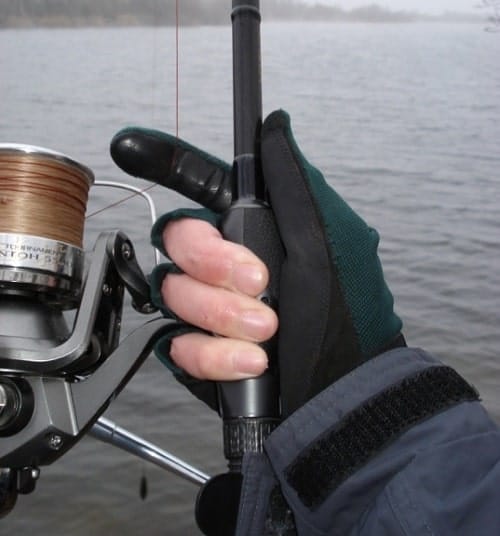
Monofilament must be fixed on the pad of a bent index finger located between the upper edge of the spool and the reel seat. Under the weight of the bait, the line is stretched and held securely during any manipulations with the tackle. When throwing, just straighten your finger a little.
Hold the spinning rod with one or two hands
When using long rods equipped with heavy baits, casting should always be done with two hands, one of which is located on the butt, and the other in the area of the reel seat. If this rule is not followed, a high-quality throw will not work.
If we are talking about fishing with light tackle of the “light” or “ultralight” class, then with certain skills you can use only one hand. For a novice spinning player who has not yet sufficiently mastered the throwing technique, it is better to always fix the tackle at two points.
Spinning casting technique
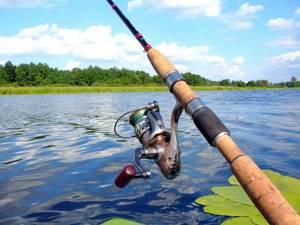
There are several basic rules. Following them will help a novice spinning player avoid initial mistakes and cast correctly, far and accurately.
Overhang of the bait
Overhang is the distance from the bait to the tip of the spinning rod. It is often recommended to make the overhang of the bait 30-40 centimeters from the tulip, as the most optimal. But here you need to take into account such characteristics as:
- Spinning rod length.
- Rigidity. Different types of bait load the spinning rod differently. If the overhang is short, the cast will be short, since the form will not be loaded enough. With an increased length, casting accuracy suffers, and inconveniences arise for the spinner.
- Bait type. Throwing a spinner (oscillating or rotating) is different from throwing a wobbler. Pinocchio is voluminous and has additional long-casting systems inside its body. In order for the system to work, the bait should be thrown with acceleration.
There are two types of line retention when casting:
- The first is when you press the line against the side of the reel spool with your index finger.
- The second, most common, is holding at the handle of the spinning rod (as in the photo).
Casting a spinning rod with one hand looks beautiful, but I still recommend giving up the apparent beauty and grasping the handle with both hands. Regardless of the blank length, weight and type of bait. Each hand performs its own function.
In principle, these are the main points that first of all need to be paid attention to when mastering the technique of casting a spinning rod for a novice fisherman. Of course, there are quite a lot of nuances and you will have to get to know them. For example, the fight against overlapping tulip fishing line.
For clarity, I can offer a video about the technique of casting a spinning rod from Kirill Gushchin, where all the episodes are perfectly described.
The video is wonderful, I just want to warn beginners against completely copying the actions of a professional when working with a loaded form. Kirill has a lot of experience and good spinning. With budget Chinese chopsticks, such tricks may not work and will lead to breakdown.
No tail, no scales. Regards, Oleg
How to accurately send bait to one place
High casting accuracy can only be achieved through long practice. A novice fisherman needs to be prepared for the fact that at the initial stage the bait will not fly where he planned. There are several rules that can help in mastering an accurate throw:
- you should not make a large overhang of the bait;
- you need to focus your attention on accuracy, and not on the throw range;
- The weight of a spoon, wobbler or jig head should always be within the test limits of the rod.
At the initial stage of mastering spinning gear, it is recommended to choose a landmark on the opposite bank and cast at it. The range can be controlled by slowing down the line coming off the spool with your hand.
Instructions on how to cast a spinning rod with an inertial reel
Casting gear with an inertial reel, including a multiplier, is done more gently than with a meat grinder, although the technique is identical - vertical, pendulum, side. We wrote about these methods in the article “Fishing with a spinning reel depending on the conditions and fishing method.” While throwing from the side is not difficult, throwing from behind the back of an inexperienced angler often ends in a beard.
How to cast a tackle far from an inertial reel depends on several characteristics, including the structure of the blank and its length, as well as the weight of the bait. Not all fishermen realize how much strength their rods have, trying to cast the equipment carefully, for fear of breaking it.
In principle, this is true, but not entirely. To get the rod to work to its full potential, you need to apply enough force to it to accelerate it to maximum speed when casting. But caution is necessary, since each form has a limit to the test range, beyond which there is no reason to cross.
How to properly cast a spinning rod with an inertial reel from the side
- when casting right-handed, the reel is located above the blank, when casting left-handed, it is under it;
- the bait is placed on a hanging line with a distance to the tip of 0.2-0.3 m;
- the scaffold is pressed against the form with a finger, the brake is turned off;
- the form is pulled back, then in a smooth movement, with acceleration, it is sent forward. The trajectory of the rod is from bottom to top, at the right moment the line is released.
How to properly cast a spinning rod with an inertial reel from behind you
- when trying to cast, you shouldn’t push the form too hard;
- at the moment of throwing, you do not need to make maximum effort;
- the bait should go into the pond in a wide arc.
If the gear is correctly selected and the technique is sufficiently worked out, throwing a small bait weighing 30 grams over a hundred meters will not be difficult. Even pickers weighing twenty grams can be cast at the same distance, and heavier baits can be cast even further.
Competitions are often held among athletes on how to throw a spinning rod with an inertial reel over extremely long distances, called casting. The world record is 132 meters, the weight of the load is 18 grams. With proper training, it is possible for an amateur to achieve similar results, but not necessarily. It is much more important to achieve casting accuracy.
A few more tips for the novice fisherman:
- You don’t need to put maximum effort into casting, you need to do it smoothly and progressively, otherwise a beard is guaranteed.
- Just before the bait touches the pond, you need to smoothly slow down the drum, while simultaneously lifting the form up.
- When guiding the bait, set it at different speeds and trajectories to imitate the natural movements of the fish.
It is widely believed that the inertial coil is an atavism of bygone days. Quite a controversial issue, for example, old fishermen catch fish very effectively with the help of inertia. So if you approach any issue competently, success will be guaranteed.
How to cast as far as possible
Casting range often determines the effectiveness of fishing, especially when it comes to catching wary fish in large bodies of water. This parameter is influenced by the following factors:
- spinning rod length;
- thickness of the fishing line used;
- wind strength and direction;
- aerodynamic qualities and weight of the bait.
The longer the spinning rod and the thinner the monofilament, the farther the tackle will fly. In headwind conditions, you should stop using wobblers and switch to more compact and heavier baits.
Basic mistakes when casting
At the initial stage of mastering spinning gear, most fishermen make the same type of mistakes, which do not allow for quality casting and often lead to the loss of bait and breakage of the rod. To avoid such troubles, you need to pay attention to a number of the following recommendations:
- Before performing a throw, you should make sure that the line guide is open;
- you never need to overload the tackle and install bait on it, the weight of which significantly exceeds the upper limit of the spinning test;
- Do not use too thick cords and fishing lines;
- There is no need to perform power throws unless necessary.
It is better to equip the rod with a reel with a low-profile spool - this will significantly increase the casting distance. It is not recommended to install the cheapest “inertia-free” Chinese-made spinning rods. Such products are not distinguished by uniform winding of the fishing line, which often leads to tangling of the monofilament and causes a lot of trouble for the fisherman.
